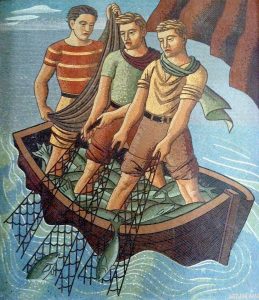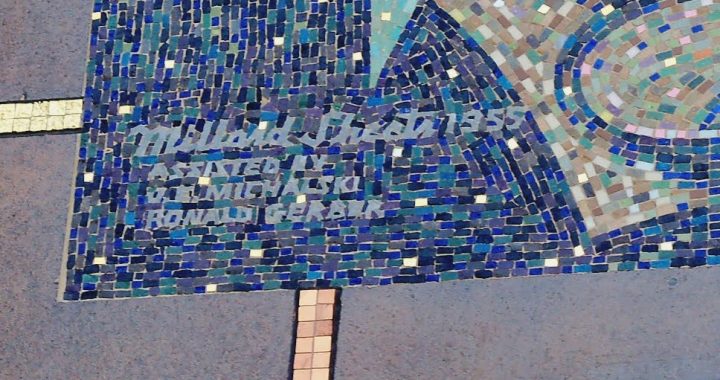
Jean Goodwin (later Ames), “Three Women Gathering at the Sea Shore,” Federal Art Project mosaic for Newport Harbor Union High School, 1937.
When Millard Sheets first designed mosaics, he sent them off to be fabricated by the Ravenna Mosaic Company of St. Louis, run by the German Heudeck family. It was only after he crossed paths with Jean Goodwin Ames and her husband Arthur Ames that Sheets could imagine fabricating mosaics in California.
Jean and Arthur met in a MFA ceramics class with Glen Lukens, at USC, where Jean created her first majolica tile mural in the Science building, Youth and Science, as her MFA thesis (image here).

Arthur Ames, “Three Fisherman,” Federal Art Project mosaic for Newport Harbor Union High School, 1937.
Goodwin and Ames both were involved in the Federal Art Project of the Works Progress Administration, and Jean, in an oral history, said that Arthur’s professor at the California School of Fine Arts, “Ray Boynton…inspired me to do the work in mosaic and so we were one of the first to do mosaic work in California and it was through his expression we did that.” (They also mention the influence of Dr. Robert King and the help of Bob Vohe.)

Bruton Sisters, “St. Francis” mosaic, San Francisco Zoo, 1934. Image via Vicki & Chuck Rogers on Flickr.
The mosaics that the Ameses produced for Newport Harbor
Union High School were likely among the first public mosaics fabricated by Americans in the state of California. The preponderance of square tiles; the heavy, dark lines; and the massive, static feel of the figures do not bear the mark of the later Sheets Studio mosaics, reflecting more the large figures of the contemporaneous Mexican muralists, and Soviet Socialist-Realists.
The material is also different. As Jean later said, “at that time it was almost impossible to get the Byzantine [glass] mosaic [tesserae] that is used in Italy, and we used native material,” hard, high-fired matte vitreous (clay) tiles from scrap heaps as well as tile from manufacturers such as Gladding McBean. But the interplay of colors to create depth, and the cut tiles that provide hints of motion—in the women’s hair, in the pelican’s feathers—show the promise of how their technique evolved.
Jean and Arthur Ames were married in 1940, and Millard Sheets recruited Jean to the faculty at Scripps College, while Arthur became Professor of Design at Otis Art Institute. Their artwork moved progressively through a number of media—paintings to mosaics to woodcuts to copper enamel to tapestries, and, in most cases, from figurative to abstract compositions.

Jean and Arthur Ames, tree mosaic for Ahmanson Trust, 9145 Wilshire, 1959-1960
The Ameses did a few mosaic commissions for the Sheets Studio – at Claremont United Church of Christ; at the Mercantile National Bank building in Dallas; at Ahmanson Trust in Beverly Hills; – as well as enamels and a lion for the first Home Savings, at 9245 Wilshire. Their interview also mentions a majolica tile mosaic for Guaranty Savings in Fresno, and work for “the Pomona Loa,” under the direction of Millard Sheets — but I am unsure what exactly that was, and its fate.
The influence of the Ameses at the Sheets Studio was mostly through the skills endowed to their students who worked in mosaic – Martha Menke Underwood and Nancy Colbath most prominent among them. The mosaic at the first Home Savings mosaic, completed 1955, is signed with the names Millard Sheets, J.E. (likely James Edgar) Michalski, and Ronald Gerber—and I am still trying to track down who these last two individuals were.
Millard Sheets, J.E. Michalski, and Ronald Gerber, mosaic for Home Savings, 9245 Wilshire, Beverly Hills, 1955. Photo via Vickey Kalambakal.
From Millard’s encouragement and Martha’s skill, the Home Savings mosaics emerged—small in size and intricacy at first, and then ever larger and more complex. After 1961, when Denis O’Connor came into the studio, Lillian Sizemore has described to me that this shift marked “a more modern trend in the Studio’s handling of the mosaic surface.”
In 1999, Newport Union demolished the building where the mosaics were, outside facing a patio—but, thankfully, their wall was preserved. They now occupy pride of place in a hallway at the entrance to the school, with a plaque describing their history.
Next week we will look at what happened after the grand era of Denis O’Connor mosaics for Home Savings — when his smaller operation could not handle the timing demands of Home Savings, expanding across the nation.
